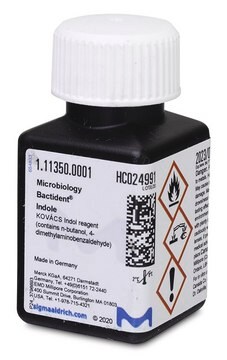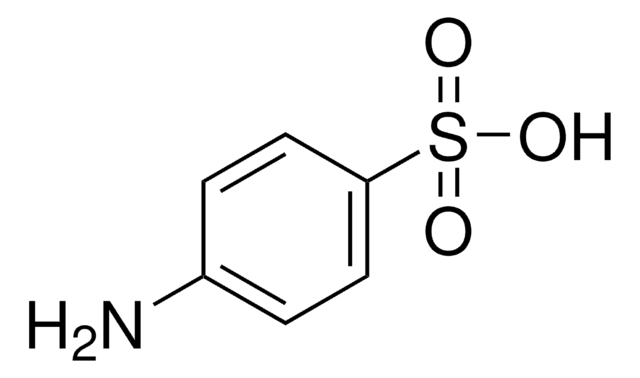60983
Kovac′s reagent for indoles
suitable for microbiology
Synonym(s):
4-(Dimethylamino)benzaldehyde solution, Indole reagent according to Kovac
About This Item
Recommended Products
shelf life
limited shelf life, expiry date on the label
Quality Level
composition
n-butanol
4-dimethylaminobenzaldehyde
hydrochloric acid
technique(s)
microbe id | specific enzyme detection: suitable
refractive index
n20/D 1.400-1.420
application(s)
agriculture
clinical testing
environmental
food and beverages
microbiology
storage temp.
2-8°C
suitability
Escherichia coli
coliforms
SMILES string
[H]C(=O)c1ccc(cc1)N(C)C
InChI
1S/C9H11NO/c1-10(2)9-5-3-8(7-11)4-6-9/h3-7H,1-2H3
InChI key
BGNGWHSBYQYVRX-UHFFFAOYSA-N
Looking for similar products? Visit Product Comparison Guide
General description
Application
Biochem/physiol Actions
signalword
Danger
Hazard Classifications
Acute Tox. 4 Oral - Eye Dam. 1 - Flam. Liq. 3 - Met. Corr. 1 - Skin Irrit. 2 - STOT SE 3
target_organs
Central nervous system, Respiratory system
Storage Class
3 - Flammable liquids
wgk_germany
WGK 1
flash_point_f
96.8 °F
flash_point_c
36 °C
ppe
Faceshields, Gloves, Goggles, type ABEK (EN14387) respirator filter
Choose from one of the most recent versions:
Already Own This Product?
Find documentation for the products that you have recently purchased in the Document Library.
Customers Also Viewed
Articles
There are many other methods of detection to indicate the presence of E. coli. Review common tests and biochemical reactions for this contaminant.
For microbiologists the most fundamental stain was developed in 1884 by the Danish bacteriologist Hans Christian Gram.
Clostridium perfringens can cause contamination in undercooked or improperly sterilized canned foods and water. Learn to detect, identify, and differentiate this pathogen.
An article concerning the detection, identification, differentiation, and cultivation of Pseudomonas species.
Our team of scientists has experience in all areas of research including Life Science, Material Science, Chemical Synthesis, Chromatography, Analytical and many others.
Contact Technical Service












